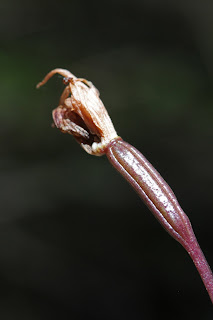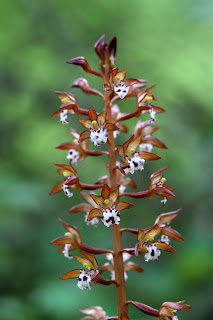May 5-11
On Friday, May 10th, I managed to get out to three different places here in Western Washington, one of them with a new friend. A fellow member of the Mount Baker Orchid Society had reported a location for the unspotted yellow form of the Western Spotted Coralroot and had put me in touch with Phyllis, who agreed to show me where it and several white Fairy Slippers could be found. This, then, is Corallorhiza maculata var. occidentalis fma. immaculata.
We were out for several hours Friday and I saw both the white Fairy Slippers she had found and the yellow Coralroots and was able to get photos of both. The Fairy Slippers are near the end of their season and the yellow Coralroots are just starting to bloom, but it was exciting and satisfying to see these rarities. I went on to several other locations (more on that below) after parting way with Phyllis, and found some other native orchids at those locations, so it was a very good day.
The white Fairy Slipper is Calypso bulbosa var. occidentalis, fma. nivea. Variety occidentalis refers to the fact that this is the Western Fairy Slipper, and forma nivea mean that this is the white form. The Coralroot is Corallorhiza maculata var. occidentalis fma. immaculata. Variety occidentalis refers again to the fact that this is the western variety of the Spotted Coralroot, and forma immaculata to the fact that it is unspotted (in this case unspotted and yellow).
We found several lighter forms of the Fairy Slipper. They seem rather common, though it is not always easy to tell if the flower is truly a lighter form or whether it has been pollinated and is dying, since they also turn white at that stage. The pure white form is quite rare, it seems, as is often the case with albino flowers and animals - rare but very beautiful. The others I saw were the normal pink color.
I found Coralroots at all three locations, the Striped Coralroot, Corallorhiza striata, and many more Western Spotted Coralroot, Corallorhiza maculata var. occidentalis, but all the normally colored forms including both the brown-stemmed (fma. intermedia), and the most common bronze-stemmed forms: http://nativeorchidsofthepacificnorthwest.blogspot.com/2012/09/variation-in-spotted-coralroot.html.
The Western Coralroot, Corallorhiza mertensiana, was just starting to bloom in one location and the flowers were not even fully opened. This location has the darkest form of this very variable species that I have found anywhere, a very dark reddish-purple. I'll have to go back and take more photos in a week or two when more are open and will then photograph other color forms at another location where we go to see them every year.
Striped Coralroot - Corallorhiza striata
Western Spotted Coralroot - Corallorhiza maculata var. occidentalis
(both bronze and brown-stemmed forms)
note the more or less rounded lip, the distinguishing characteristic of this variety
The Western Coralroot, Corallorhiza mertensiana, was just starting to bloom in one location and the flowers were not even fully opened. This location has the darkest form of this very variable species that I have found anywhere, a very dark reddish-purple. I'll have to go back and take more photos in a week or two when more are open and will then photograph other color forms at another location where we go to see them every year.




















































great shots as always. I failed today, but we will see what tomorrow brings. GPS are a fickle thing and I did not take the narrative you sent( my mistake).
ReplyDeleteBut it is never a dull moment in these parks
I am really disappointed that your trip today was in vain. I suppose that a trip to any place in the mountains or in our beautiful PNW is not wasted, but I am truly disappointed.
DeleteCorallorhiza maculata very beautiful
ReplyDeleteThanks, my friend, for commenting. The Coralroot is indeed beautiful and is probably our most common orchid after the Goodyera.
DeleteWow! What colorful plants! You really hit it big, Ron. Thanks for sharing your images with us...
ReplyDeleteJim Fowler, Greenville, SC
This was a very good day in the annals of our orchid hunting. Thanks for commenting, Jim.
Delete